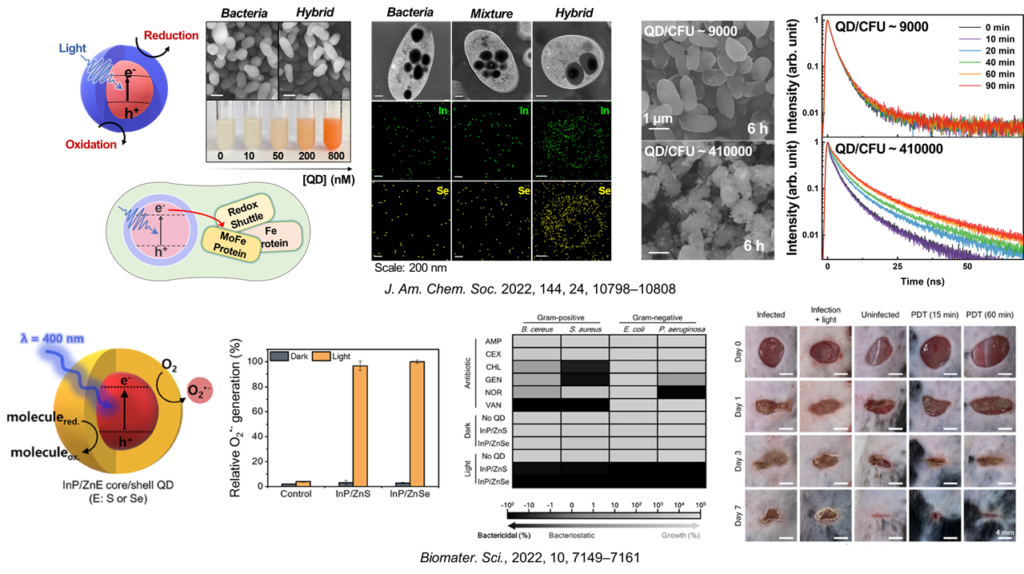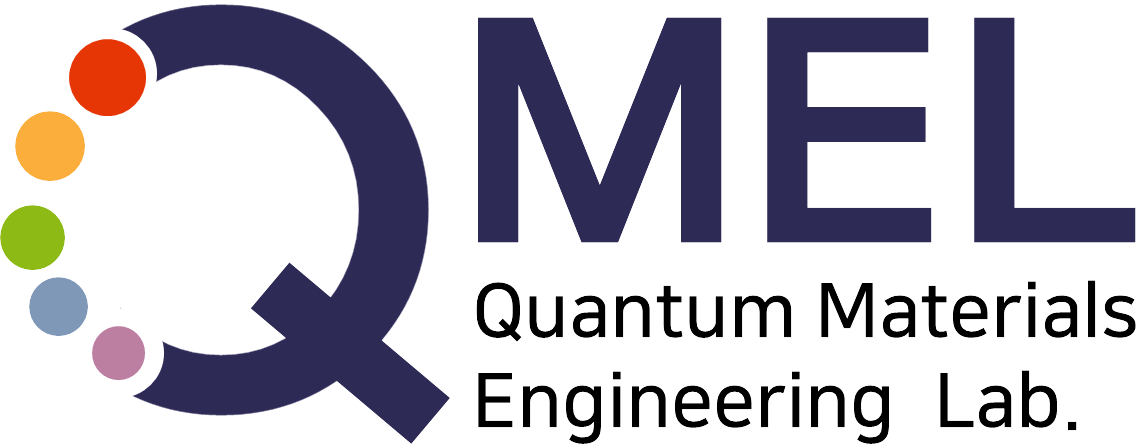QD-Bio Photoreaction

효소는 생체 내에서 필요한 물질을 생물학적, 화학적으로 합성하기 위한 촉매로 기질 특이성(substrate specificity)을 바탕으로 온화한 조건에서도 선택적 반응을 유도하며 화학 반응 활성화 에너지를 낮춰 물질대사를 촉진시킨다. 단일 숙주 내의 효소 매개 화학반응은 전통적인 화학반응에 비해 매우 높은 반응 선택성을 보이지만, 물질대사에 의해 효소 발현 및 반응이 조절되어 그 속도가 제한적이며 낮은 생산성을 갖는다.
본 연구실은 양자점을 이용하여 생체 내 효소의 산화환원반응을 효과적으로 유도 및 조절하여 친환경, 고효율, 고부가가지 물질 생산 시스템 구축에 관한 연구를 진행 중이다. 높은 흡광계수를 가지는 무기 나노입자와 박테리아의 동시배양 전략을 통해 나노입자를 세포 내부로 합입시켜 박테리아-양자점 하이브리드 시스템을 구축하고, 박테리아-양자점 하이브리드 시스템에 빛을 조사하여 in vivo에서 양자점과 효소 간 상호작용을 유도하며, 이를 통해 기존 효소 및 야생형 박테리아의 효소 촉매 반응 속도 및 물질대사 속도를 획기적으로 증가시킬 수 있다. 이에 본 연구실은 양자점 표면과 구조 디자인을 통해 박테리아 내부로의 양자점 전달량을 조절하고 양자점–효소 간 상호작용과 양자역학적 전자 전달 기작을 규명하는 연구를 수행한다. 이에 더하여, 생성물의 종류와 생성 속도를 조절하여 암모니아, 키랄 의약품, 연료 합성 및 고전적인 화학공정을 대체할 온화한 조건에서의 친환경 화학물질 대량생산에 관한 연구를 수행하고 있다.
Enzymes serve as catalysts in living organisms, synthesizing necessary substances both biologically and chemically, based on substrate specificity. They induce selective reactions even under mild conditions and lower the activation energy of chemical reactions to accelerate metabolism. Enzyme-mediated chemical reactions within a single host exhibit much higher reaction selectivity compared to traditional chemical reactions. However, these reactions often have limited rates and low productivity due to metabolic regulation that controls enzyme expression and activity.
Our laboratory is currently conducting research on the development of an eco-friendly, high-efficiency, and high-value-added substance production system by effectively inducing and regulating redox reactions of enzymes in living organisms using quantum dots. By co-cultivating bacteria with inorganic nanoparticles, which have high absorption coefficients, we introduce these nanoparticles into cells to construct a bacteria-quantum dot hybrid system. Light is applied to the bacteria-quantum dot hybrid system to induce interactions between quantum dots and enzymes in vivo, which can significantly increase the speed of enzyme-catalyzed reactions and metabolism of conventional enzymes and wild-type bacteria. Through this, our laboratory controls the amount of quantum dots delivered inside bacteria, conducting research to elucidate the interactions between quantum dots and enzymes and the quantum-mechanical electron transfer mechanism. Additionally, our research is focused on the mass production of eco-friendly chemicals under mild conditions. This involves replacing traditional chemical processes by manipulating the types and rates of products focusing on ammonia, chiral pharmaceuticals, and fuel synthesis
다제내성균은 다양한 종류의 항생제에 대해 저항성을 갖는 균을 말한다. 이러한 균들은 전염성이 높을 뿐만 아니라 일반적인 항생제 치료에 의해 제거되기 어렵다. 따라서 새로운 항생제 개발과 함께 감염 통제 및 관리에 대한 지속적인 연구가 필요한 상황이지만 그 속도가 다제내성균의 출현 속도에 비해 더딘 상황이다.
양자점은 광감응제로써 빛을 받아 표면에서 산화 환원 반응을 일으킬 수 있다. 특히 생체 내에서 양자점은 빛을 받아 전자를 생성하고, 그 표면에서 산소를 환원시켜 활성 산소종을 생성한다. 이러한 활성 산소종은 강력한 반응성을 갖기 때문에 생체 조직을 공격하고 세포를 손상시킨다. 본 연구실은 이러한 양자점의 특성을 이용하여 생체 내 국부적인 활성산소종 형성을 유도하고, 궁극적으로 다제내성균의 감염 치료에 관한 연구를 진행하고 있다.
Multidrug-resistant bacteria (MDR) refer to bacteria that have developed resistance to various types of antibiotics. These bacteria not only exhibit high infectivity but are also challenging to eliminate through conventional antibiotic treatments. Consequently, continuous research into infection control and management, along with the development of new antibiotics, is necessary. However, the progress in this area is slower compared to the emergence of MDR.
Quantum dots are photosensitive agents capable of inducing oxidation-reduction reactions on their surfaces when irradiated with light. Within the body, quantum dots generate electrons upon exposure to light, leading to the reduction of oxygen on their surfaces and the generation of reactive oxygen species. These reactive oxygen species possess strong reactivity, which can damage biological tissues and cells. Therefore, our research laboratory is leveraging the properties of these quantum dots to induce the localized formation of reactive oxygen species within the body, ultimately researching the treatment of infections caused by MDR.
